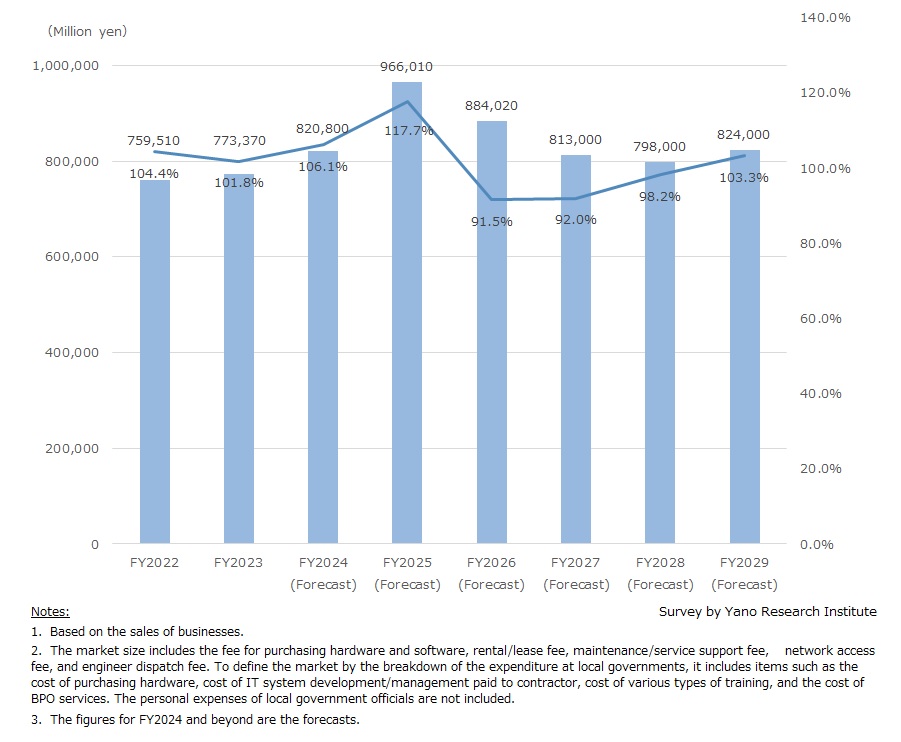No.3784
Local Government Solutions Market in Japan: Key Research Findings 2025
Local Government Solutions for FY2024 Estimated at 820,800 Million Yen, Up 6.1% YoY
Yano Research Institute (the President, Takashi Mizukoshi) has conducted a survey on the domestic market of IT solutions for local governments, and found out the general condition of the market, future perspectives, and the trends of service providers.

Market Overview
The size of local government solutions market in FY2024 was estimated to have grown by 6.1% from the preceding fiscal year to 820,800 million yen, based on the sales of businesses (IT vendors). The growth was underpinned by the full-scale mission-critical system migration by Japanese local governments in response to the digital government initiative.
With only two years remaining until the the March 2026 deadline, local governments have accelerated unification/standardization of their core systems in FY2024. This gave a significant rise to the sales of vendors providing systems compliant to the government standard specifications.
However, very few have completed (or started) system migration and integration in FY2024: most local governments scheduled the transition in FY2025. For this reason, the market in FY2025 is projected to grow markedly at 17.7% increase from FY2024 to reach 966,010 million yen.
Noteworthy Topics
Concerns for Slow Transition
In order to reduce costs at municipalities, the government has decided to integrate/standardize the mission critical system of local governments (information systems used in municipal affairs, such as resident records and taxation) by the end of FY2025 and host them on the government cloud procured by the Digital Agency. Currently, IT vendors are investing a lot of human resources to achieve the transition by the deadline.
In 2024, some local governments have advanced to shift to new systems in full-scale. However, the numbers are still very limited; most of them plan on the transition in FY2025. In detail, the migration is scheduled to avoid the time of seasonal peaks in workload, thus starting around summer and completing sometime between fall and winter. Some vendors may deal with multiple municipalities at once.
While many projects are underway, some municipalities are projected to miss the deadline, stemming from the complexity of updating legacy systems (that are often proprietary) and vendor withdrawal. A certain number of vendors gave up as they were challenged with intricate technical requirements and upfront investment in developing standard-compliant system and integrating with government cloud. When existing vendor walks away, the local government has to find another vendor and end up spending longer reconstructing new systems. Meanwhile, nationwide demand for migration all at once is aggravating the engineer shortage at vendors.
Acknowledging the challenges in migrating legacy systems, in December 2024, the national government made an announcement allowing local governments designated for “Specific Transition Support” to extend deadline practically for five years. The flexibility to develop in phases helps avoid disruptions. Large-scale local governments with complex legacy systems that have intricate requirements for migration, as well as municipalities in need of finding new vendors, are projected to complete migration after FY2026.
Future Outlook
The local government solutions market in Japan is expected to undergo significant structural transformation. Beginning in FY2026, demand will primarily come from municipalities designated for “Specific Transition Support” and those planning to replace their mission-critical systems. In this environment, a vendor’s experience (achievements) and the quality of support they offer will be key factors in the selection process.
Following the implementation of compliant systems, local government will shift their focus to digital transformation (DX). Demand is already growing for enhanced public services, such as ‘counter’(in-person) operations, online application, and e-contracts. Beyond internal digitalization, local governments are increasingly looking at how technology can directly improve the lives of residents.
This momentum has attracted new entrants from diverse industries, including mobility, finance, and healthcare. At the same time, the adoption of generative AI is accelerating. As experts with a deep understanding of public services and operational know-how, conventional vendors are expected to lead the way, while also collaborating with emerging players.
Research Outline
2.Research Object: IT vendors providing solutions for local governments, local governments
3.Research Methogology: Face-to-face interviews by our expert researchers (including online interviews), survey via telephone and email, and literature research.
What is the Local Government Solutions Market?
In this research, local government solutions indicate IT systems introduced by local governments. The market size includes the fee for purchasing hardware and software, rental/lease fee, maintenance/service support fee, network access fee, and engineer dispatch fee.
To define the market by the breakdown of the expenditure at local governments, it includes items such as the cost of purchasing hardware, cost of IT system development/management paid to contractor, cost of various types of training, and the cost of BPO services. The personal expenses of local government officials are not included.
<Products and Services in the Market>
Mission-critical systems for local governments (information systems used in municipal affairs, such as resident records and taxation), IT solutions for organization management of local government, IT solutions for field workers, solutions related to digital transformation (DX) of local governments, etc.
Published Report
Contact Us
The copyright and all other rights pertaining to this report belong to Yano Research Institute.
Please contact our PR team when quoting the report contents for the purpose other than media coverage.
Depending on the purpose of using our report, we may ask you to present your sentences for confirmation beforehand.